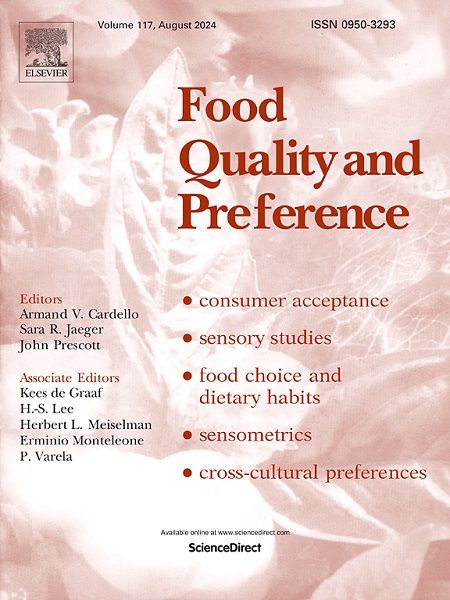健康的标签,健康的分量?有利的营养评分对消费者份量选择和食物摄入量的影响
IF 4.9
1区 农林科学
Q1 FOOD SCIENCE & TECHNOLOGY
引用次数: 0
摘要
虽然人们发现包装正面标签对购买意愿和食物选择有积极影响,但它们对份量和食物摄入量的潜在负面影响仍未得到充分研究。我们把重点放在了nutrition - score上,这是一个包装正面的标签,用五色字母组合来总结食品的营养质量。我们测试了有利的营养评分(A和B)是否增加了消费者的份量和他们的实际食物摄入量。在五个在线实验中,研究人员向参与者展示了六张食物份量的照片,并让他们选择不吃四到十二种产品。在两个实验室实验中,我们测量了在同一场合食用的两种食物的重量。结果不支持我们的主要主张,即有利的营养分数的存在,与没有营养分数相比,会导致更大的选择份量和增加的食物摄入量。结果也不支持有利的营养评分对份量大小或食物摄入量的间接影响,通过(1)适当份量的感知,(2)使用产品健康作为辩护线索,或(3)减少内疚感。没有支持发现感知产品健康作为调节效果。这些研究结果意味着好消息,因为它们表明,通过有利的营养评分来促进更健康的选择并不会无意中导致更大的份量或食物摄入量。这对政策制定者、零售商和制造商具有重要意义。本文章由计算机程序翻译,如有差异,请以英文原文为准。
Healthy labels, healthy portions? The impact of favorable nutri-scores on consumers' portion size selection and food intake
While front-of-pack labels have been found to positively impact purchase intentions and food choices, their potential negative impact on portion sizes and food intake remains understudied. We focused on the Nutri-Score, a front-of-pack label that summarizes the nutritional quality of foods with a five color-letter combination. We tested whether favorable Nutri-Scores (A and B) increased consumers' portion sizes and their actual food intake. In five online experiments, participants were presented with six portion size photographs and an option to not consume for four to twelve products per study. In two lab experiments, we measured the weight of two foods consumed on a single occasion. The results do not support our main proposition that the presence of favorable Nutri-Scores, compared to the absence of Nutri-Scores, would lead to larger selected portion sizes and an increased food intake. Neither did the results support an indirect effect of favorable Nutri-Scores on portion sizes or food intake via (1) perceptions of appropriate portion sizes, (2) the use of product healthiness as a justification cue, or (3) reduced guilt feelings. No support was found for perceived product healthiness as a moderator of the effects. These research findings mean good news, as they suggest that promoting healthier options through favorable Nutri-Scores does not inadvertently lead to larger portions or food intake. This has important implications for policy makers, retailers, and manufacturers.
求助全文
通过发布文献求助,成功后即可免费获取论文全文。
去求助
来源期刊

Food Quality and Preference
工程技术-食品科技
CiteScore
10.40
自引率
15.10%
发文量
263
审稿时长
38 days
期刊介绍:
Food Quality and Preference is a journal devoted to sensory, consumer and behavioural research in food and non-food products. It publishes original research, critical reviews, and short communications in sensory and consumer science, and sensometrics. In addition, the journal publishes special invited issues on important timely topics and from relevant conferences. These are aimed at bridging the gap between research and application, bringing together authors and readers in consumer and market research, sensory science, sensometrics and sensory evaluation, nutrition and food choice, as well as food research, product development and sensory quality assurance. Submissions to Food Quality and Preference are limited to papers that include some form of human measurement; papers that are limited to physical/chemical measures or the routine application of sensory, consumer or econometric analysis will not be considered unless they specifically make a novel scientific contribution in line with the journal''s coverage as outlined below.
 求助内容:
求助内容: 应助结果提醒方式:
应助结果提醒方式:


